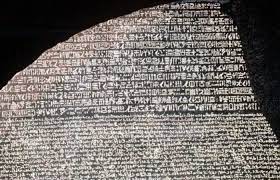‘Language of Gods’ Stone from 2,220 Years Ago Discovered In Egyptian Temple
The discovery of a stone that allegedly contains the “language of Gods” and was uncovered in an ancient Egyptian temple recently made news. Many people have been startled and fascinated by this.
This is reportedly the Rosetta Stone. It is among the most well-known items in the British Museum. According to legend, the stone’s history dates to King Ptolemy V’s reign, which lasted from 204 to 181 BC (or around 2,220 years ago). According to the researchers, his command is recorded on the inscription, which has been reproduced throughout time and identical stones that resemble it have been placed in several temples around Egypt.
Jack posted the article on X, previously known as Twitter. Time for a little language, history, and today about the Rosetta Stone, he said in a tweet. Without a question, the Rosetta Stone is the most significant human representation of language translation in history. Nothing else comes close since it instantaneously enables us to interpret two languages that were long believed to be gone.
The two untranslated languages, Demotic and Hieroglyphics, were from ancient Egypt, the author continued. Before their discovery, it seemed doubtful that they would ever be cracked since there wasn’t a place to begin our translation. Additionally, learning a language from scratch is really difficult.
The Rosetta Stone is unfortunately imperfect and fractured. There are only 14 lines of hieroglyphic writing that have been translated, and the remaining “language of the Gods” is absent. According to accounts, two brilliant individuals named Thomas Young and Jean François Champollion interpreted the hieroglyphs around 1822. The “language of the Gods” is said to have been first understood by these two individuals.
According to accounts, three pieces of the inscriptions were discovered in Egypt’s ancient ruins. The top half of the fragments featured inscriptions of a sort of speech used in writing for official writings, while the following pieces had inscriptions of those papers’ and tales’ colloquial language.







